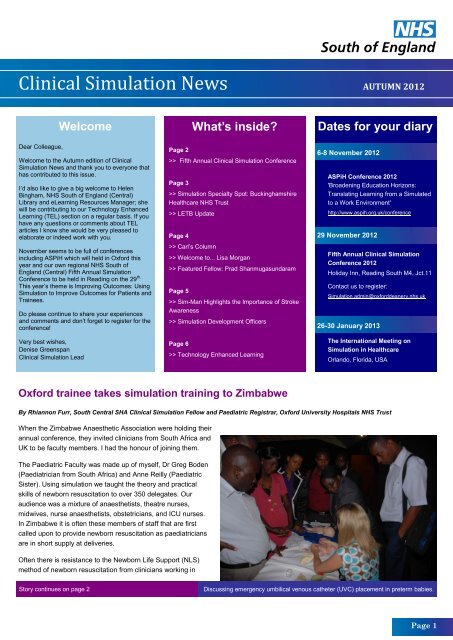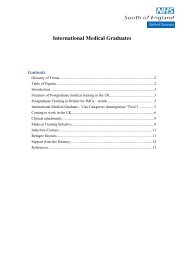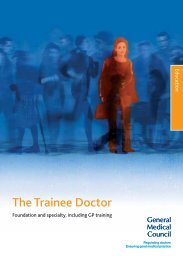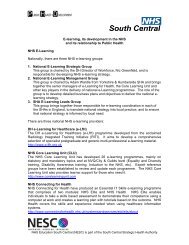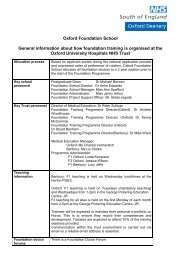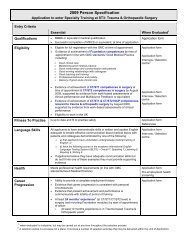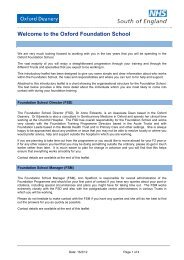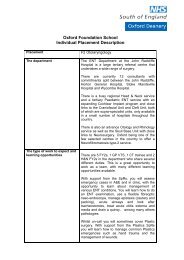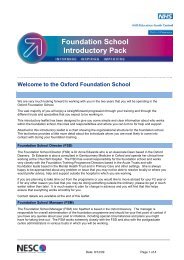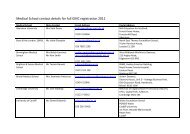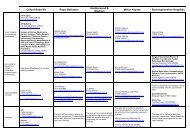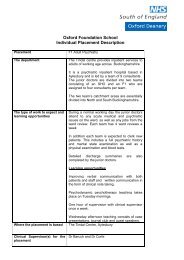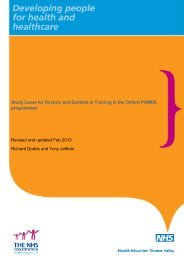Clinical Simulation News ( Autumn 2012).pdf - Oxford Deanery
Clinical Simulation News ( Autumn 2012).pdf - Oxford Deanery
Clinical Simulation News ( Autumn 2012).pdf - Oxford Deanery
- No tags were found...
You also want an ePaper? Increase the reach of your titles
YUMPU automatically turns print PDFs into web optimized ePapers that Google loves.
<strong>Clinical</strong> <strong>Simulation</strong> <strong>News</strong> AUTUMN <strong>2012</strong>WelcomeWhat’s inside?Dates for your diaryDear Colleague,Welcome to the <strong>Autumn</strong> edition of <strong>Clinical</strong><strong>Simulation</strong> <strong>News</strong> and thank you to everyone thathas contributed to this issue.I’d also like to give a big welcome to HelenBingham, NHS South of England (Central)Library and eLearning Resources Manager; shewill be contributing to our Technology EnhancedLearning (TEL) section on a regular basis. If youhave any questions or comments about TELarticles I know she would be very pleased toelaborate or indeed work with you.November seems to be full of conferencesincluding ASPiH which will held in <strong>Oxford</strong> thisyear and our own regional NHS South ofEngland (Central) Fifth Annual <strong>Simulation</strong>Conference to be held in Reading on the 29 th.This year’s theme is Improving Outcomes: Using<strong>Simulation</strong> to Improve Outcomes for Patients andTrainees.Do please continue to share your experiencesand comments and don’t forget to register for theconference!Very best wishes,Denise Greenspan<strong>Clinical</strong> <strong>Simulation</strong> LeadPage 2>> Fifth Annual <strong>Clinical</strong> <strong>Simulation</strong> ConferencePage 3>> <strong>Simulation</strong> Specialty Spot: BuckinghamshireHealthcare NHS Trust>> LETB UpdatePage 4>> Carl’s Column>> Welcome to... Lisa Morgan>> Featured Fellow: Prad ShanmugasundaramPage 5>> Sim-Man Highlights the Importance of StrokeAwareness>> <strong>Simulation</strong> Development OfficersPage 6>> Technology Enhanced Learning6-8 November <strong>2012</strong>ASPiH Conference <strong>2012</strong>'Broadening Education Horizons:Translating Learning from a Simulatedto a Work Environment'http://www.aspih.org.uk/conference29 November <strong>2012</strong>Fifth Annual <strong>Clinical</strong> <strong>Simulation</strong>Conference <strong>2012</strong>Holiday Inn, Reading South M4, Jct.11Contact us to register:<strong>Simulation</strong>.admin@oxforddeanery.nhs.uk26-30 January 2013The International Meeting on<strong>Simulation</strong> in HealthcareOrlando, Florida, USA<strong>Oxford</strong> trainee takes simulation training to ZimbabweBy Rhiannon Furr, South Central SHA <strong>Clinical</strong> <strong>Simulation</strong> Fellow and Paediatric Registrar, <strong>Oxford</strong> University Hospitals NHS TrustWhen the Zimbabwe Anaesthetic Association were holding theirannual conference, they invited clinicians from South Africa andUK to be faculty members. I had the honour of joining them.The Paediatric Faculty was made up of myself, Dr Greg Boden(Paediatrician from South Africa) and Anne Reilly (PaediatricSister). Using simulation we taught the theory and practicalskills of newborn resuscitation to over 350 delegates. Ouraudience was a mixture of anaesthetists, theatre nurses,midwives, nurse anaesthetists, obstetricians, and ICU nurses.In Zimbabwe it is often these members of staff that are firstcalled upon to provide newborn resuscitation as paediatriciansare in short supply at deliveries.Often there is resistance to the Newborn Life Support (NLS)method of newborn resuscitation from clinicians working inStory continues on page 2Discussing emergency umbilical venous catheter (UVC) placement in preterm babies.Page 1
<strong>Clinical</strong> <strong>Simulation</strong> <strong>News</strong> | <strong>Autumn</strong> <strong>2012</strong>developing countries. In many parts of Africa, midwives prefer to hold babies upside down, slaptheir bottoms to stimulate crying, and use blind suctioning to clear the secretions that areperceived to be preventing the baby from crying. Indeed, this is what most of the delegatesreported as being common practice on the delivery suite in Zimbabwe.However, we found that this myth was easy to dispel. By teaching on the physiology of birth (hownormal babies clear up to 100ml fluid from their lungs just by crying), we were able to explain thatsuctioning the oropharynx will not help clear the lungs of babies that are not breathing. We thenreinforced the methods by working through practical simulation scenarios. Each delegate wasguided through a scenario of newborn resuscitation with one-to-one support by a faculty member.They were encouraged to work as a team to provide full cardiopulmonary resuscitation.With a captive audience, we also ran sessions on Adult, Child and Infant resuscitation. Thesewere run jointly by the international faculty and a team from MARS (Medical Air Rescue Services,Zimbabwe) using a combination of low-fidelity and high-fidelity mannequins.Practising infant life support techniques.I gauged the success of our teaching methods by the end-of-conference quiz. Whilst delegatesstumbled over questions on pre-eclampsia and managing difficult airways, they performedexceedingly well on aspects of neonatal care. It had been tiring to teach Newborn Resuscitationindividually to hundreds of clinicians, but our efforts had paid off.The Fifth Annual NHS South of England (Central)<strong>Clinical</strong> <strong>Simulation</strong> Training ConferenceImproving Outcomes: Using <strong>Simulation</strong> Training to Improve Outcomes for Patients and TraineesThursday 29 November <strong>2012</strong>, Holiday Inn Reading SouthThe aim of the conference is to share best practice and encourage a simulation network across NHS South ofEngland (Central), thereby improving outcomes for both patients and trainees.Morning Keynote Speech- The National Perspective:Professor Bryn Baxendale, President of ASPiH.Afternoon Keynote Session- Debriefing: CollaborativeJourney from Objectivity to Personal Technical &Professional Truth: Dr David Grant, Chair of BristolMedical <strong>Simulation</strong> Centre, UH Bristol NHS FoundationTrust.Presentations by the NHS South of England (Central)<strong>2012</strong> <strong>Clinical</strong> <strong>Simulation</strong> Fellows.Exhibition of posters from all current NHS South ofEngland (Central) <strong>Simulation</strong> Fellows.This event is free to attend, however you will have to register in advance and spaces are limited.For further information and to register please contact Liliane Johnston by calling 01865 740 603 or by email:simulation.admin@oxforddeanery.nhs.uk or liliane.johnston@oxforddeanery.nhs.uk.Page 2
<strong>Simulation</strong> Specialty Spot: Buckinghamshire Healthcare NHS TrustBy Tania Davison, <strong>Clinical</strong> <strong>Simulation</strong> Fellow and Senior General Paediatric Trainee, Buckinghamshire Healthcare NHS TrustBucks launches a simulation-based, multi-professional paediatric end of life care study dayThe death of a child is a tragedy which has an enormous impact not only on the family but also on the professionals involved.Thankfully it is a relatively uncommon event but that in itself along with society’s general ‘death anxiety’ highlights the need for highquality education in this area.On 29 August, Buckinghamshire Healthcare NHS Trust ran a one-day multi-professional course designed to improve professionals’communication with families during this time. The day was supported and introduced by the Director of Medical Education: Dr SallyEdmonds. After an interactive lecture on the practical and legal aspects of death, the group was split up to allow scenario baseddiscussions on how to support families after a sudden unexpected death. Bereavement advice was given by Jenni Thomas OBE,founder of the Child Bereavement Charity and bereavement counsellor for the Angus Lawson Memorial Trust. She also supported abereaved mother to tell her story to the group providing a powerful illustration of the parent’s perspective.The afternoon was spent using simulation in the form of interactive demonstrations or the goldfish bowl technique. In this method thelearners sit in a semi circle and watch as the facilitation team carry out a role play. The scenario is stopped at a certain point and thelearners are asked to suggest words the characters might use to deal with a particular communication problem. Different suggestionsare then tried out to see their implications. This method was chosen as it allows more participants to interact and give their own ideason different approaches without them feeling threatened or having to take part in role plays themselves. A collaboration with BucksNew University provided drama students to play the role of the parents and facilitators were used in the role of the professionals.Scenarios were designed to explore the difficulties with initiating advanced care planning discussions, dealing with conflict betweenparents and picking up cues from the families.The day was attended by a wide range of senior nurses from the emergency department to paediatric community nurses as well assenior paediatric medical trainees. Both groupsparticularly commented on the value of learning in amulti-professional arena. Feedback wasoverwhelmingly positive and pre and post coursequestionnaires showed a significant improvement inthe professional’s confidence in having difficultdiscussions with families either leading up to or afterthe death of a child.Due to popular demand another day will be run at theend of February at Stoke Mandeville Hospital and itwill become a regular event on the Trust’s educationalcalendar. We are also hoping to roll out similar daysin Trusts around the region.Anyone interested in more information can contactpaediatriceolc@gmail.com.Participants observe as a nurse discusses end of life plans with a mother of a dying child.New structure puts future workforce decisions in hands of employersBy Caroline Crabtree, Stakeholder Engagement and Communications Manager, NHS South of EnglandTwo new organisations are being developed in South Central to lead the education and training of the healthcare and public health workforcefrom 1 April 2013. Local Education and Training Boards (LETBs) are membership organisations who are responsible for ensuringthat healthcare providers have the right staff with the right skills at the right time. Responsibility for workforce planning, educationcommissioning and the postgraduate deaneries will pass from strategic health authorities to LETBs.In South Central, Thames Valley LETB will lead education and training for organisations in Berkshire, Buckinghamshire, Milton Keynesand <strong>Oxford</strong>shire. Wessex LETB takes on the same role for organisations in Hampshire, Isle of Wight, Dorset and Salisbury. All LETBswill operate as sub-committees of a national organisation called Health Education England (HEE) which takes on the role of MedicalEducation England alongside new responsibilities.The driver for the new structures is to improve patient care by ensuring that decisions about the education and training of the current andfuture workforce are made by employers themselves. Find our more online at www.workforce.southcentral.nhs.ukPage 3
<strong>Clinical</strong> <strong>Simulation</strong> <strong>News</strong> | <strong>Autumn</strong> <strong>2012</strong>Carl’s ColumnBy Carl Read, SimCentre Manager atUniversity Hospital SouthamptonMaking SimMan bubble andswingWe run a course here at SouthamptonGeneral Hospital called WessexOneLung and the team from Bristolwho wrote the course came up with asimple way of making SimMan operatea chest drain bottle in a realistic way.We pulled the lung fitting off his rightmain bronchus and attached a lengthof silicone tubing from an old suctionpump that is brought out from his torsoat the abdomen section. By doubleclamping this pipe, we could hold avolume of fake blood ready for whenthe chest drain is ‘inserted’ under thedrapes. The chest drain bottle thenbubbles and swings and the fake blooddrains down from the chest drain in ahighly satisfactory way.Welcome to...Lisa Morgan,<strong>Simulation</strong> Trainer,Royal Bournemouthand ChristchurchNHS FoundationTrustI have very recently been appointed asthe <strong>Simulation</strong> Lead within the RoyalBournemouth and Christchurchhospital. This is a brand new role forthe organisation so it is a very excitingposition to be in. My role is to develop afaculty of simulation educators, todevelop simulation educationprogrammes and to embed its use ineducation to meet local objectives. Thisis to be multi-disciplinary as the role islead by professional development andmedical education.I have a clinical background inemergency nursing and have beenworking in simulation for three and ahalf years in another acute trust. I wasalso one of the NHS South Central<strong>Clinical</strong> <strong>Simulation</strong> and Patient SafetyFellows of 2011.The Royal Bournemouth Hospital istaking simulation to new levels: it hasjust purchased a state of the artophthalmology simulator, of whichthere is only one other in the region.Featured Fellow: Prad ShanmugasundaramBy Prad Shanmugasundaram, <strong>Clinical</strong> <strong>Simulation</strong> Fellow and Anaesthetic and ICM SpecialtyRegistrar, Royal Berkshire NHS Foundation TrustSupervisor: Dr Debbie Rosenorn-Lanng, Consultant Anaesthetist,Director of <strong>Simulation</strong> and HQI, Royal Berkshire NHS Foundation TrustI was appointed as a <strong>Clinical</strong> <strong>Simulation</strong> Fellow to map theanaesthetic curriculum to simulation. This project has developed intoseveral streams:1. Development of a generic scenario templateAn early priority has been to standardise the design of simulationscenarios produced across the region. There is currentlyconsiderable variation in scenario design which can cause difficultiesfor faculty delivering training sessions at several sites, and may alsolead to barriers to sharing simulation resources.To reduce this variability, a generic scenario template has been produced for the use of all<strong>Clinical</strong> <strong>Simulation</strong> Fellows. Use of this template ensures a comprehensive approach andconsistently high quality of scenarios produced on behalf of the SHA.The generic template has been adopted to design scenarios for healthcare professionalsfrom a variety of disciplines including: nurses of various specialties (Paediatric and neonatal,Critical care and Outreach, Emergency department); Advanced theatre practitioners andtrainee ODPs; Paramedics; Air ambulance crew; Doctors of various specialties (Anaesthesiaand intensive care, Paediatrics and neonatology, Surgery, General medicine, Obstetrics,Emergency medicine, Acute medicine).2. Mapping the anaesthetic curriculum to simulationThis process has been facilitated by the Royal College of Anaesthetists <strong>Simulation</strong> SteeringGroup who have been undertaking a curriculum mapping exercise and have been willing togenerously share their work.3. Producing and trialling a library of curriculum-mapped scenarios for anaesthetictrainingTo date, over 30 distinct scenarios have been produced and delivered to anaesthetic,intensive care and Acute Care Common Stem (ACCS) trainees, primarily at the RoyalBerkshire Hospital, but also at Wexham Park and Stoke Mandeville Hospitals. Thesescenarios have been mapped to specific modules from the curriculum, including airway,critical incidents, intensive care, novice, obstetrics and paediatrics.An additional patient safety module has been developed. The scenarios in this module havearisen from analysis of the National Patient Safety Agency (NPSA) and other patient safetygroup alerts, Department of Health ‘Never events’ and regular ongoing review of criticalincidents within the trust.4. Embedding scenarios into anaesthetic training and education: LocallyThese scenarios have been embedded into the regular anaesthetic simulation training at theRoyal Berkshire Hospital. Several scenarios from the intensive care module have beenadopted for use during departmental induction training to the intensive care unit at the RoyalBerkshire Hospital. These scenarios have also been delivered to advanced anaesthetictheatre practitioners and ODP trainees locally.5. Embedding scenarios into anaesthetic training and education: RegionallyI have been a key member of the team that has designed and delivered the new Readinessfor the Initial Assessment of Competency Training (RIACT) Course. This is a unique modulartraining course for all of the novice anaesthetic and ACCS trainees in the <strong>Oxford</strong> <strong>Deanery</strong>.The course is comprised of six days spread across the first three months of anaesthetictraining and aims to facilitate the achievement of the Initial Assessment of CompetencyCertificate. This is a key objective required before a trainee can join an on-call rota anddeliver anaesthesia under local or distant supervision. The course includes a mix of lectures,workshops and simulation training. For further information please visit www.riact.org.uk.The developing scenario library has been available to members of the simulation faculty(including the current simulation fellows) at numerous hospitals across the region. Thescenario template has been adopted at Wexham Park Hospital and other centres and hasbeen used to design and deliver training scenarios for anaesthetic and ACCS trainees.Page 4
<strong>Clinical</strong> <strong>Simulation</strong> <strong>News</strong> | <strong>Autumn</strong> <strong>2012</strong>Technology Enhanced LearningBy Helen Bingham, Library and elearning Resources Manager for NHS South of England (Central)New formula F1 induction at <strong>Oxford</strong> University Hospitals TrustJunior doctors who joined <strong>Oxford</strong> University Hospitals NHS Trust (OUH) this summer were the first to undertake an online Trust inductionprogramme which uses interactive clinical scenarios to assess competence, capability and performance and promote understandingthrough decision making. Locally filmed video clips provide welcome messages and orientation, and key local policies are embedded incontext within the learning.Over 90% of the F1 doctors completed the induction before commencing at the Trust on 1 August, theremainder soon after, and their feedback was generally very positive. Work is nowunder way to incorporate enhancements and some additional scenarios, and there isdiscussion about the possibility of creating versions for other Trusts. There is even thepossibility of introducing ‘passport style’ induction, whereby Foundation doctorscomplete the generic parts of the induction once, and just locally specific elements oneach rotation.A preview link to the OUH induction is available at http://www.dynamicfileshare.co.uk/<strong>Oxford</strong>/<strong>Clinical</strong>_Induction/clinical_induction.html: right click on the 100% loaded screen, and select ‘play’.Pre-hospital care modules added to BMJ LearningBMJ Learning contains over 900 evidence-based online learning modules which are writtenby experts and cover a wide range of clinical and non-clinical topics – now including a rangeof pre-hospital care topics. BMJ Learning is FREE to all staff in the NHS South of England(Central) area. Access is via NHS Athens (which also provides access to a range of otherelectronic information resources, including databases, e-journals and e-books).To access BMJ Learning, go to http://learning.bmj.com/scsha and select ‘login via Athens’. Ifyou don’t already have an Athens account, or have forgotten your password, go to https://register.athensams.net/nhs/nhseng/. BMJ offer free online tutorials in the use of BMJ Learning; if you are interested, please contactHelen Bingham (helen.bingham@nesc.nhs.uk).The National NHS eLearning RepositoryThe recently re-styled NHS eLearning Repository (http://www.elearningrepository.nhs.uk/) has been designed as discovery portal forlearning materials created for healthcare audiences, with the joint aims of encouraging use and reducing duplication of NHS-fundedlearning resources. It is being promoted for use by everyone involved in commissioning or developing eLearning, as something to searchbefore initiating a new development, and somewhere to put a description of the finished product afterwards.At present, the Repository mainly contains descriptions of, and where possible download links to, eLearning modules. However, it isbeing promoted as something to use for other learning ‘objects’ such as videos, animations, podcasts and even written guides – andthere is no reason it could not be extended to include simulation resources and materials.Anyone can search the Repository, and any member of NHS staff can register for a login to add content. Commercially developedresources with traditional “all rights reserved” licences can be added, but there is the alternative option of using a “Creative Commons”licence which enable commissioners and/or creators of eLearning content to retain copyright whilst also allowing others to copy,distribute, and make some uses of their work — at least non-commercially.If you have any ideas or information that you would like to contribute to this newsletter than we’d love to hear from you!Please contact Denise Greenspan at the following email address: denise.greenspan@oxforddeanery.nhs.uk.Page 6


